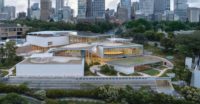Tel Aviv, Israel
Preston Scott Cohen, architect of the recently opened expansion to the Tel Aviv Museum of Art, refers to the addition’s exterior as “the urban version” of the building’s Lightfall—the spiraling skylit atrium and circulation space that vertically connects the new galleries. But for reasons of expense, instead of enclosing the building with sensuous curved surfaces similar to those that define the twisting interior space, Cohen opted for a curtain-wall system of precast-concrete panels. No two of the 465 panels are alike, but most are in the shape of quadrilaterals or triangles, and some are as long as 30 feet on a side. They fit together to create a subtly faceted wrapper made up of large folded planes.
Primarily because of the difficulty of finding a precast manufacturer with the necessary expertise, the project team elected to produce the 5-inch-thick cladding elements at the building site, according to Israel Chaskelevitch, principal of the eponymous firm that served as the construction manager through late 2009. Keeping the fabrication process on-site also helped avoid the damage that might occur during transportation, especially to the panels’ vulnerable knifelike edges and sharp corners.
Starting in March 2009, and for more than a year after that, contractors cast the panels in a fabrication plant they set up within an already enclosed lower-level gallery. Using smooth, steel-topped tables as the base of the panels’ formwork and reconfigurable magnetic dams to define the different shapes and angles, they cast each panel in two layers, placing steel reinforcement before the second pour. The process ensured that contractors could provide the required amount of concrete cover for this reinforcement—an especially important detail due to Tel Aviv’s corrosive salt air, Chaskelevitch points out.
The back of the panels incorporate steel plates that serve as the connection points to an underlying support system of vertical steel ribs placed every 8 feet on center and anchored to the building’s primary Vierendeel truss structure. With cranes, workers lifted the panels, which weigh as much as 9 tons, into place, and then adjusted their position from behind before welding the embedded steel plates to the structural armature. Finally, they filled the resulting ¹¹∕¹6 -inch joint between each cladding piece with a special combination of sealants recessed about an inch from the surface to create a reveal.
Although the facade material wasn’t specified in Cohen’s 2003 competition entry, he always envisioned the addition’s exterior as concrete. He preferred it over other materials, he explains, because he wanted to tie his expansion to Tel Aviv’s modern architecture and the mostly exposed concrete and white stucco buildings that have earned it the moniker “the White City.” He hoped to avoid making a building that seemed like it belonged in Jerusalem, he says, where everything is built of honey-colored stone.
The client, however, had other preferences, and the drawings released for bid in 2007 called for stone-clad, cast-in-place concrete walls. The architect credits the construction manager for devising the curtain-wall-and-precast solution and for winning over the reluctant client with full-sized mock-ups of a 30-foot-square portion of both proposed assemblies. Not only was the precast option less expensive, but it also allowed for larger cladding elements—especially for the cladding suspended from the soffits, where the weight of the stone would have necessitated small, mosaic-like pieces. “The sheer size and smoothness of the panels was overwhelmingly impressive,” says Cohen, referring to the concrete mock-up. Amit Nemlich, project architect, confirms that the final cladding solution was the most appropriate one. “Tel Aviv is a new city,” he says, “and concrete is a modern material.”
People |
Products |






